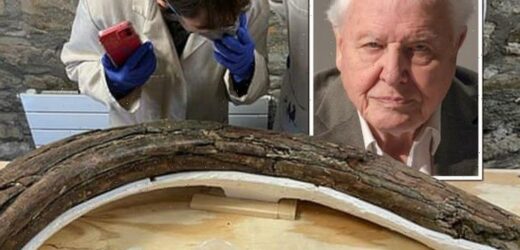Ancient Greece: Archaeologists on 'special' discovery
We use your sign-up to provide content in ways you’ve consented to and to improve our understanding of you. This may include adverts from us and 3rd parties based on our understanding. You can unsubscribe at any time. More info
Palaeontologists were astonished by the preserved remains of two adults, two juveniles and an infant, who roamed Earth around 200,000 years ago, in a gravel quarry, near Swindon. Furthermore, they also unearthed prehistoric tools used by Neanderthals to hunt these gigantic beasts at the same site. Given that they have only excavated a fraction of the site, archaeologists believe that they may have found a treasure trove of prehistoric fossils.
Aside from the discovery of the mammoths, they have also found several creatures of a range of sizes.
Some of the larger fossils include ice age elks, who were twice as large as their modern descendant, with antlers 10ft across.
Meanwhile, there were a variety of smaller creatures including seeds, freshwater snails, dung beetles, pollen and plant fossils, all preserved at the site.
These discoveries will now offer clues into how our Neanderthal ancestors lived in the harsh conditions of ice-age Britain, a period of prehistory about which little is known.


The extraordinary finds will be explored in a BBC One documentary, Attenborough and the Mammoth Graveyard, to be aired on 30 December, in which Sir David Attenborough and evolutionary biologist Professor Ben Garrod join archaeologists from DigVentures to film the excavation.
Prof Garrod described it as one of the most important discoveries in British palaeontology.
He said that while the odd mammoth bone often turns up, it is “incredibly rare” to find such complete skeletons.
Speaking to the Observer, he added: “Where these mammoths lie in the ground is exactly where they died a quarter of a million years ago – next to incredible things like stone tools and the snails they trampled underfoot.”

Sir David added: “The finds of this remarkable site have given us a rare glimpse of early Britain, a time when humans were fully immersed in the wild, living as part of Nature.
“It is thought that Neanderthals may have been around for some 400,000 years.
“Their survival relied on their instinctive understanding of the natural world.
“Whether our own species can thrive for quite as long remains to be seen.”

Lisa Westcott Wilkins of DigVentures, an archaeology social enterprise, said: “Archaeological sites from this period are rare, and critical for understanding Neanderthal behaviour across Britain and Europe.
“Why did so many mammoths die here? Could Neanderthals have killed them? What can they tell us about life in ice-age Britain?
“The range of evidence at this site gives us a unique chance to address these questions.”
The researchers believe that this find dates back to around 220,000 years ago.

At the time, Britain was still occupied by Neanderthals during a warmer interglacial period known as MIS7.
This period had marked by its lush, fertile plain which drew in both animals and humans as they were forced down south by falling temperatures.
The earliest prehistoric mammoths came from Africa about five million years ago.
This particular species, the Steppe mammoth, was the largest among them and weighed up to 15 tonnes, more than twice the weight of an African elephant.
Source: Read Full Article


